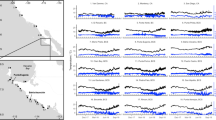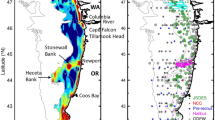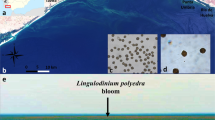Abstract
Hypoxic (oxygen concentrations <2.5mg l−1) and occasionally anoxic bottom waters occur along the inner continental shelf of Texas and Louisiana1–4. Little is known, however, about the spatial and temporal scales of these hypoxic areas. Boesch5 concludes the nearshore continental shelf west of the Mississippi River Delta has characteristics potentially favourable for large-scale bottom water oxygen depletion. These characteristics include influences from river and marsh discharges of freshwaters, rich in nutrients and sediments, The river effluent flows over the higher salinity shelf waters, creating two-layer vertical density stratification. When surface waters are heated during the summer, vertical stability increases, especially during calm wind periods, and vertical eddy diffusion is limited. Large-scale phytoplankton blooms stimulated by nutrients from the freshwater runoff can then produce large amounts of organic matter which sink and, through respiration and decomposition, deplete oxygen concentrations in the bottom layer. The hypoxia is normally limited to several metres of the water column next to the bottom6 in water depths usua <50m. Because hypoxia appears to be related to surface chlorophyll and temperature, which can both be measured with the Coastal Zone Color Scanner (CZCS) on board the Nimbus 7 spacecraft7,8, we have tried to determine if conditions favourable for formation of hypoxia could be detected and monitored from space. A linear discriminant function successfully identified areas of bottom water hypoxia detected by research vessels up to 10 days after satellite overpass. The discriminant function also successfully predicted hypoxic areas in June 1983 without resort to research vessel data. Shrimp and finfish were absent in the hypoxic zones; hence, the mapping from space of conditions favourable for hypoxia development may have significant marine resource implications for both strategic fishing and management.
This is a preview of subscription content, access via your institution
Access options
Subscribe to this journal
Receive 51 print issues and online access
$199.00 per year
only $3.90 per issue
Buy this article
- Purchase on Springer Link
- Instant access to full article PDF
Prices may be subject to local taxes which are calculated during checkout
Similar content being viewed by others
References
Stunz, W. E., Sanders, N., Leming, T. D., Baxter, K. N. & Barazotto, R. M. Coastal Oceanogr. Climatol. News 4, 37–38 (1982).
Bedinger, C. A. Jr, Childers, R. E., Cooper, J., Kimball, K. T. & Kwok, A. in Ecological Investigations of Petroleum Production Platforms in the Central Gulf of Mexico, 1–53 (Rep. BLM Contract AA5551-CT8017 Southwest Research Institute, Texas, 1981).
Ragan, J. G., Harris, A. H. & Green, J. H. Prof. Pap. Ser. Biol. 3, (Nicholls State Univ., 1978).
Turner, R. E. & Allen, R. L. Contr. mar. Sci. 25, 161–172 (1982).
Boesch, D. F. Coastal Ocean Pollut. Assess. News 2, 25–28 (1983).
Turner, R. E. & Allen, R. L. Contr. mar. Sci. 25, 173–179 (1982).
Hovis, W. A. et al. Science 210, 60–63 (1980).
Gordon, H. R. et al. Science 210, 63–66 (1980).
Gordon, H. R. & Clark, D. K. Appl. Opt. 20, 4175–4180 (1981).
Smith, R. C. & Wilson, W. H. in Oceanography From Space (ed. Gower, J. F. R.) 281–294 (Plenum, New York, 1981).
Clark, D. K. in Oceanography from Space (ed. Gower, J. F. R.) 227–237 (Plenum, New York, 1981).
Gordon, H. R. et al. Appl. Opt. 22, 20–36 (1983).
Smith, R. C. & Baker, K. S. Mar. Biol. 66, 269–279 (1982).
Yentsch, C. S. in Remote Sensing Applications in Marine Science and Technology (ed Cracknell, A. P.) 263–297 (Reidel, Hingham, 1983).
Clark, D. K., Baker, E. T. & Strong, A. E. Boundary-Layer Met. 18, 287–298 (1980).
Harper, D. E., McKinney, L. D., Salzer, R. B. & Case, R. J. Contr. mar. Sci. 24, 53–79 (1981).
Author information
Authors and Affiliations
Rights and permissions
About this article
Cite this article
Leming, T., Stuntz, W. Zones of coastal hypoxia revealed by satellite scanning have implications for strategic fishing. Nature 310, 136–138 (1984). https://doi.org/10.1038/310136a0
Received:
Accepted:
Issue Date:
DOI: https://doi.org/10.1038/310136a0
This article is cited by
-
Abundance and Distribution of Reef-Associated Fishes Around Small Oil and Gas Platforms in the Northern Gulf of Mexico’s Hypoxic Zone
Estuaries and Coasts (2018)
-
Nitrate uptake in an agricultural stream estimated from high-frequency, in-situ sensors
Environmental Monitoring and Assessment (2018)
-
Effects of Hypoxia on Fish Survival and Oyster Growth in a Highly Eutrophic Estuary
Estuaries and Coasts (2018)
-
Relationships Between Long-Term Trend of Satellite-Derived Chlorophyll-a and Hypoxia Off the Changjiang Estuary
Estuaries and Coasts (2017)
-
Coastal eutrophication near the Mississippi river delta
Nature (1994)
Comments
By submitting a comment you agree to abide by our Terms and Community Guidelines. If you find something abusive or that does not comply with our terms or guidelines please flag it as inappropriate.



